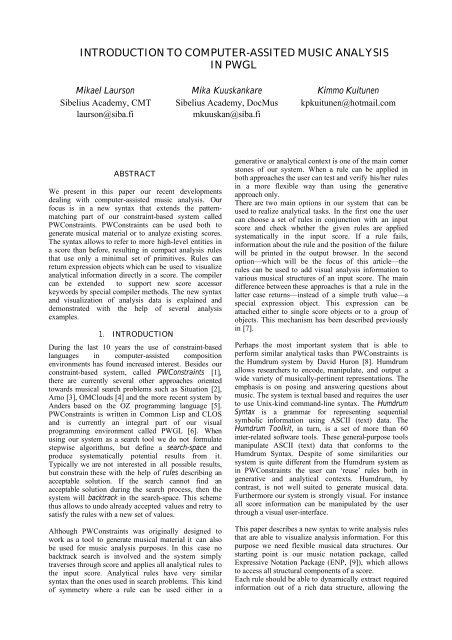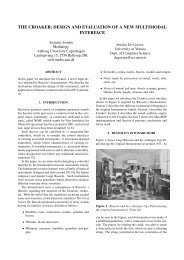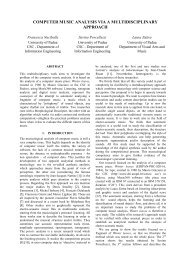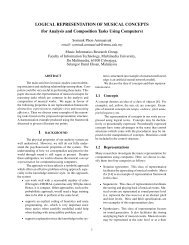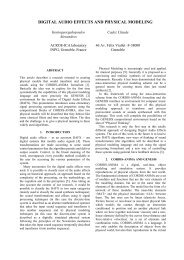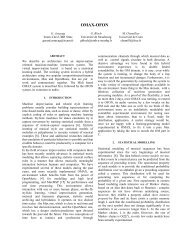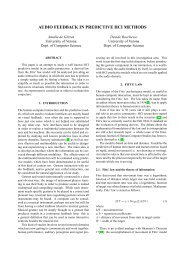introduction to computer-assited music analysis in pwgl - Sound and ...
introduction to computer-assited music analysis in pwgl - Sound and ...
introduction to computer-assited music analysis in pwgl - Sound and ...
You also want an ePaper? Increase the reach of your titles
YUMPU automatically turns print PDFs into web optimized ePapers that Google loves.
INTRODUCTION TO COMPUTER-ASSITED MUSIC ANALYSIS<br />
IN PWGL<br />
Mikael Laurson Mika Kuuskankare Kimmo Kuitunen<br />
Sibelius Academy, CMT Sibelius Academy, DocMus kpkuitunen@hotmail.com<br />
laurson@siba.fi<br />
mkuuskan@siba.fi<br />
ABSTRACT<br />
We present <strong>in</strong> this paper our recent developments<br />
deal<strong>in</strong>g with <strong>computer</strong>-assisted <strong>music</strong> <strong>analysis</strong>. Our<br />
focus is <strong>in</strong> a new syntax that extends the patternmatch<strong>in</strong>g<br />
part of our constra<strong>in</strong>t-based system called<br />
PWConstra<strong>in</strong>ts. PWConstra<strong>in</strong>ts can be used both <strong>to</strong><br />
generate <strong>music</strong>al material or <strong>to</strong> analyze exist<strong>in</strong>g scores.<br />
The syntax allows <strong>to</strong> refer <strong>to</strong> more high-level entities <strong>in</strong><br />
a score than before, result<strong>in</strong>g <strong>in</strong> compact <strong>analysis</strong> rules<br />
that use only a m<strong>in</strong>imal set of primitives. Rules can<br />
return expression objects which can be used <strong>to</strong> visualize<br />
analytical <strong>in</strong>formation directly <strong>in</strong> a score. The compiler<br />
can be extended <strong>to</strong> support new score accessor<br />
keywords by special compiler methods. The new syntax<br />
<strong>and</strong> visualization of <strong>analysis</strong> data is expla<strong>in</strong>ed <strong>and</strong><br />
demonstrated with the help of several <strong>analysis</strong><br />
examples.<br />
1. INTRODUCTION<br />
Dur<strong>in</strong>g the last 10 years the use of constra<strong>in</strong>t-based<br />
languages <strong>in</strong> <strong>computer</strong>-assisted composition<br />
environments has found <strong>in</strong>creased <strong>in</strong>terest. Besides our<br />
constra<strong>in</strong>t-based system, called PWConstra<strong>in</strong>ts [1],<br />
there are currently several other approaches oriented<br />
<strong>to</strong>wards <strong>music</strong>al search problems such as Situation [2],<br />
Arno [3], OMClouds [4] <strong>and</strong> the more recent system by<br />
Anders based on the OZ programm<strong>in</strong>g language [5].<br />
PWConstra<strong>in</strong>ts is written <strong>in</strong> Common Lisp <strong>and</strong> CLOS<br />
<strong>and</strong> is currently an <strong>in</strong>tegral part of our visual<br />
programm<strong>in</strong>g environment called PWGL [6]. When<br />
us<strong>in</strong>g our system as a search <strong>to</strong>ol we do not formulate<br />
stepwise algorithms, but def<strong>in</strong>e a search-space <strong>and</strong><br />
produce systematically potential results from it.<br />
Typically we are not <strong>in</strong>terested <strong>in</strong> all possible results,<br />
but constra<strong>in</strong> these with the help of rules describ<strong>in</strong>g an<br />
acceptable solution. If the search cannot f<strong>in</strong>d an<br />
acceptable solution dur<strong>in</strong>g the search process, then the<br />
system will backtrack <strong>in</strong> the search-space. This scheme<br />
thus allows <strong>to</strong> undo already accepted values <strong>and</strong> retry <strong>to</strong><br />
satisfy the rules with a new set of values.<br />
Although PWConstra<strong>in</strong>ts was orig<strong>in</strong>ally designed <strong>to</strong><br />
work as a <strong>to</strong>ol <strong>to</strong> generate <strong>music</strong>al material it can also<br />
be used for <strong>music</strong> <strong>analysis</strong> purposes. In this case no<br />
backtrack search is <strong>in</strong>volved <strong>and</strong> the system simply<br />
traverses through score <strong>and</strong> applies all analytical rules <strong>to</strong><br />
the <strong>in</strong>put score. Analytical rules have very similar<br />
syntax than the ones used <strong>in</strong> search problems. This k<strong>in</strong>d<br />
of symmetry where a rule can be used either <strong>in</strong> a<br />
generative or analytical context is one of the ma<strong>in</strong> corner<br />
s<strong>to</strong>nes of our system. When a rule can be applied <strong>in</strong><br />
both approaches the user can test <strong>and</strong> verify his/her rules<br />
<strong>in</strong> a more flexible way than us<strong>in</strong>g the generative<br />
approach only.<br />
There are two ma<strong>in</strong> options <strong>in</strong> our system that can be<br />
used <strong>to</strong> realize analytical tasks. In the first one the user<br />
can choose a set of rules <strong>in</strong> conjunction with an <strong>in</strong>put<br />
score <strong>and</strong> check whether the given rules are applied<br />
systematically <strong>in</strong> the <strong>in</strong>put score. If a rule fails,<br />
<strong>in</strong>formation about the rule <strong>and</strong> the position of the failure<br />
will be pr<strong>in</strong>ted <strong>in</strong> the output browser. In the second<br />
option—which will be the focus of this article—the<br />
rules can be used <strong>to</strong> add visual <strong>analysis</strong> <strong>in</strong>formation <strong>to</strong><br />
various <strong>music</strong>al structures of an <strong>in</strong>put score. The ma<strong>in</strong><br />
difference between these approaches is that a rule <strong>in</strong> the<br />
latter case returns—<strong>in</strong>stead of a simple truth value—a<br />
special expression object. This expression can be<br />
attached either <strong>to</strong> s<strong>in</strong>gle score objects or <strong>to</strong> a group of<br />
objects. This mechanism has been described previously<br />
<strong>in</strong> [7].<br />
Perhaps the most important system that is able <strong>to</strong><br />
perform similar analytical tasks than PWConstra<strong>in</strong>ts is<br />
the Humdrum system by David Huron [8]. Humdrum<br />
allows researchers <strong>to</strong> encode, manipulate, <strong>and</strong> output a<br />
wide variety of <strong>music</strong>ally-pert<strong>in</strong>ent representations. The<br />
emphasis is on pos<strong>in</strong>g <strong>and</strong> answer<strong>in</strong>g questions about<br />
<strong>music</strong>. The system is textual based <strong>and</strong> requires the user<br />
<strong>to</strong> use Unix-k<strong>in</strong>d comm<strong>and</strong>-l<strong>in</strong>e syntax. The Humdrum<br />
Syntax is a grammar for represent<strong>in</strong>g sequential<br />
symbolic <strong>in</strong>formation us<strong>in</strong>g ASCII (text) data. The<br />
Humdrum Toolkit, <strong>in</strong> turn, is a set of more than 60<br />
<strong>in</strong>ter-related software <strong>to</strong>ols. These general-purpose <strong>to</strong>ols<br />
manipulate ASCII (text) data that conforms <strong>to</strong> the<br />
Humdrum Syntax. Despite of some similarities our<br />
system is quite different from the Humdrum system as<br />
<strong>in</strong> PWConstra<strong>in</strong>ts the user can ‘reuse’ rules both <strong>in</strong><br />
generative <strong>and</strong> analytical contexts. Humdrum, by<br />
contrast, is not well suited <strong>to</strong> generate <strong>music</strong>al data.<br />
Furthermore our system is strongly visual. For <strong>in</strong>stance<br />
all score <strong>in</strong>formation can be manipulated by the user<br />
through a visual user-<strong>in</strong>terface.<br />
This paper describes a new syntax <strong>to</strong> write <strong>analysis</strong> rules<br />
that are able <strong>to</strong> visualize <strong>analysis</strong> <strong>in</strong>formation. For this<br />
purpose we need flexible <strong>music</strong>al data structures. Our<br />
start<strong>in</strong>g po<strong>in</strong>t is our <strong>music</strong> notation package, called<br />
Expressive Notation Package (ENP, [9]), which allows<br />
<strong>to</strong> access all structural components of a score.<br />
Each rule should be able <strong>to</strong> dynamically extract required<br />
<strong>in</strong>formation out of a rich data structure, allow<strong>in</strong>g the
ule <strong>to</strong> analyse the result from its own po<strong>in</strong>t of view.<br />
One of the ma<strong>in</strong> problems <strong>in</strong> formulat<strong>in</strong>g such rules is<br />
<strong>to</strong> f<strong>in</strong>d a clear formalism with which <strong>to</strong> po<strong>in</strong>t <strong>to</strong> the<br />
required data objects. This article presents a new<br />
approach that allows <strong>to</strong> access <strong>in</strong> a uniform way various<br />
structural entities from a score, such as chords, beats,<br />
measures <strong>and</strong> harmonic formations. A similar approach<br />
but <strong>in</strong> a generative context has been published by us <strong>in</strong><br />
[10].<br />
In the follow<strong>in</strong>g we first <strong>in</strong>troduce the general rule<br />
syntax <strong>in</strong> PWConstra<strong>in</strong>ts. We discuss some problems<br />
found <strong>in</strong> the previous implementation <strong>and</strong> propose a<br />
new syntax that allows <strong>to</strong> add <strong>in</strong> the rules score accessor<br />
keywords (Section 3). Next (Section 4) we give an<br />
overview how the user can def<strong>in</strong>e various analytical<br />
expression objects that will be added <strong>to</strong> the score dur<strong>in</strong>g<br />
the <strong>analysis</strong> process. The new syntax is utilized <strong>to</strong> write<br />
melodic, harmonic <strong>and</strong> voice-lead<strong>in</strong>g rules (Sections 5,<br />
6 <strong>and</strong> 7). We end with a larger example that aims <strong>to</strong><br />
demonstrate how the system can be used <strong>in</strong> a concrete<br />
analytical context (Section 8).<br />
2. RULE SYNTAX<br />
In a PWConstra<strong>in</strong>ts <strong>analysis</strong> rule a pattern-match<strong>in</strong>g<br />
language is used <strong>to</strong> extract relevant <strong>in</strong>formation from a<br />
score. This <strong>in</strong>formation is given <strong>to</strong> a Lisp function,<br />
called Lisp-code part, that either returns an expression<br />
object or nil. In the latter case the rule has no side<br />
effects <strong>and</strong> the score will not be changed.<br />
The pattern-match<strong>in</strong>g part of a rule uses a fairly typical<br />
pattern-match<strong>in</strong>g syntax. It can conta<strong>in</strong> variables<br />
(symbols start<strong>in</strong>g with a ‘?’), anonymous-variables<br />
(pla<strong>in</strong> ‘?’s), a wild card (‘*’) <strong>and</strong> <strong>in</strong>dex-variables<br />
(symbols consist<strong>in</strong>g of an ‘i’ <strong>and</strong> an <strong>in</strong>dex number). A<br />
variable extracts s<strong>in</strong>gle values. By contrast, an<br />
anonymous-variable is never bound <strong>to</strong> a value, i.e. it<br />
only acts as a ‘place-holder’ <strong>in</strong> the pattern. The wild<br />
card matches any cont<strong>in</strong>uous part of the score. F<strong>in</strong>ally,<br />
an <strong>in</strong>dex-variable extracts values from an absolute<br />
position. Below we give some pattern-match<strong>in</strong>g<br />
examples with their respective b<strong>in</strong>d<strong>in</strong>gs (<strong>in</strong> order <strong>to</strong><br />
clarify the examples the pattern below the <strong>in</strong>put is<br />
formatted with the help of spaces so that it matches its<br />
<strong>in</strong>put):<br />
<strong>in</strong>put: ( 1 2 3 4 5)<br />
pattern: (?1 ? ? ?2 ?)<br />
match: ?1 = 1, ?2 = 4<br />
<strong>in</strong>put: (1 2 3 4 5)<br />
pattern: (i1 i2 i5)<br />
match: i1 = 1, i2 = 2, i5 = 5<br />
<strong>in</strong>put: (1 2 3 4 5)<br />
pattern: (* ?1)<br />
match: * = (1 2 3 4), ?1 = 5<br />
<strong>in</strong>put: (1 2 3 4)<br />
pattern: (* ?1 ?2)<br />
match: * = (1 2), ?1 = 3, ?2 = 4<br />
<strong>in</strong>put: (1 2 3 4 5 6 7)<br />
pattern: (?1 * ?2 ?3)<br />
match: * = (2 3 4 5), ?1 = 1, ?2 = 6, ?3 = 7<br />
For example an <strong>analysis</strong> rule that adds an expression<br />
denot<strong>in</strong>g the <strong>in</strong>terval between all adjacent melodic<br />
pitches found <strong>in</strong> a score can be written as follows (this<br />
rule uses a wild card <strong>and</strong> two variables):<br />
(* ?1 ?2 ;; pattern-match<strong>in</strong>g part<br />
(?if<br />
;; Lisp-code part<br />
(add-expression ‘group ?1 :<strong>in</strong>fo (- (m ?2) (m ?1)))<br />
"<strong>in</strong>terval rule") ;;documentation str<strong>in</strong>g<br />
In the old syntax the variables <strong>in</strong> the pattern-match<strong>in</strong>g<br />
part always refer <strong>to</strong> note objects. This scheme has been<br />
useful as the note objects of the <strong>in</strong>put score conta<strong>in</strong><br />
potential <strong>in</strong>formation of the current <strong>music</strong>al context,<br />
such as <strong>in</strong>strument, part, pitch, metrical position <strong>and</strong><br />
harmony. The expressions ‘(m ?1)’ <strong>and</strong> ‘(m ?2)’ denote<br />
the pitch-values of the notes referred by the variables<br />
‘?1’ <strong>and</strong> ‘?2’ (‘m’ st<strong>and</strong>s here for ‘midi’).<br />
While the old syntax has proven <strong>to</strong> be useful rules can<br />
occasionally be quite hard <strong>to</strong> def<strong>in</strong>e <strong>and</strong> underst<strong>and</strong>. One<br />
reason for this difficulty is the fact that the variables<br />
always refer <strong>to</strong> the most low-level entity of the score<br />
(i.e. note objects), even if the rule works with more<br />
high-level concepts like chords, beats, measures or<br />
harmonies. Another difficulty is that the system<br />
strongly prefers melodic formations <strong>and</strong> the patternmatch<strong>in</strong>g<br />
part is useful ma<strong>in</strong>ly when writ<strong>in</strong>g melodic<br />
rules. If the user wants <strong>to</strong> write for <strong>in</strong>stance a harmonic<br />
rule then the required structural <strong>in</strong>formation has <strong>to</strong> be<br />
accessed <strong>in</strong> the Lisp-code part by us<strong>in</strong>g special Lisp<br />
help functions. Thus when writ<strong>in</strong>g non-melodic rules<br />
the user has <strong>to</strong> have knowledge about the<br />
implementation details of the system <strong>and</strong> master a large<br />
library of help functions. F<strong>in</strong>ally, as one has <strong>to</strong> be<br />
conscious of implementation details the cod<strong>in</strong>g of new<br />
rules or Lisp help functions can become a complex <strong>and</strong><br />
error prone process.<br />
3. SCORE ACCESSOR SYNTAX<br />
This section presents a new pattern-match<strong>in</strong>g syntax that<br />
allows the user <strong>to</strong> specify special score accessors, which<br />
provide the user with a more high-level <strong>and</strong> <strong>in</strong>tuitive<br />
approach when work<strong>in</strong>g with analytical rules. The<br />
variables given <strong>in</strong> the pattern-match<strong>in</strong>g part of a rule can<br />
now refer <strong>to</strong> the structural entity the user is <strong>in</strong>terested<br />
<strong>in</strong>, such as note, chord, beat, measure <strong>and</strong> harmony. The<br />
novel compiler is modular <strong>and</strong> new score accessors can<br />
be added <strong>in</strong>crementally.<br />
The new syntax has many benefits: rules tend <strong>to</strong> be<br />
more compact <strong>and</strong> simple; the pattern match<strong>in</strong>g<br />
language can be used systematically for all k<strong>in</strong>ds of<br />
valid accessors; the user typically needs <strong>to</strong> know only a<br />
h<strong>and</strong>ful primitives <strong>in</strong> order <strong>to</strong> write new rules; potential<br />
bugs can be localized more easily as the most complex<br />
part of the system is localized <strong>in</strong> the compiler <strong>and</strong> not<br />
<strong>in</strong> user code.<br />
In the new syntax the compiler accepts an optional score<br />
accessor keyword that def<strong>in</strong>es the type of the variables<br />
that are declared <strong>in</strong> the pattern-match<strong>in</strong>g part. If the rule
has no accessor keyword then the compiler assumes that<br />
the variables refer <strong>to</strong> note objects. For <strong>in</strong>stance <strong>in</strong> the<br />
"<strong>in</strong>terval rule" rule the variables ‘?1’ <strong>and</strong> ‘?2’ are notes.<br />
Valid accessor keywords are: ‘:chord’, ‘:beat’,<br />
‘:measure’, ‘:harmony’, <strong>and</strong> ‘:score-sort’. This list can<br />
be extended by add<strong>in</strong>g appropriate compiler methods for<br />
the new accessor keyword.<br />
Another important change <strong>in</strong> our syntax is the function<br />
‘m’—which was already mentioned <strong>in</strong> the previous rule<br />
examples—that used <strong>to</strong> return the pitch-value (i.e. the<br />
MIDI key-number) of a note. The current version of ‘m’<br />
is now more general as it can return besides pitch-values<br />
also lists <strong>and</strong> objects (thus ‘m’ st<strong>and</strong>s henceforth for<br />
‘multi-accessor’). Now ‘m’ is def<strong>in</strong>ed as a method<br />
where the receiver or the first argument can be any<br />
variable type def<strong>in</strong>ed by the score accessor keyword.<br />
This means that the behaviour of ‘m’ depends on its<br />
first argument. For <strong>in</strong>stance if the first argument is a<br />
note then ‘m’ returns a s<strong>in</strong>gle numeric value; if the first<br />
argument is ‘:chord’, ‘:beat’, ‘:measure’, or ‘:harmony’<br />
then ‘m’ returns a list of pitch-values. The ‘m’ method<br />
accepts also a number of optional keyword arguments<br />
that greatly enhances the functionality of this method.<br />
Keyword arguments can be used either <strong>to</strong> modify or<br />
filter the result or they can return a flag (i.e. either true<br />
or false). Currently the follow<strong>in</strong>g keyword arguments<br />
are supported: ‘:<strong>in</strong>t’, ‘:harm-<strong>in</strong>t’, ‘:m<strong>in</strong>’, ‘:max’, ‘:part’,<br />
‘attack-item’, ‘:complete-case?’, ‘:object’ <strong>and</strong> ‘:previtem’.<br />
For <strong>in</strong>stance the ‘:<strong>in</strong>t’ keyword allows <strong>to</strong> convert<br />
a list of pitch-values <strong>in</strong><strong>to</strong> a list of <strong>in</strong>tervals; ‘:m<strong>in</strong>’<br />
results <strong>in</strong> the m<strong>in</strong>imum <strong>and</strong> ‘:max’ <strong>in</strong> the maximum<br />
value of a pitch-value list; ‘:part’ filters pitch-values so<br />
that ‘m’ returns only a pitch-value belong<strong>in</strong>g <strong>to</strong> a given<br />
part.<br />
The ‘:complete-case?’ keyword relates <strong>to</strong> one specific<br />
concept <strong>in</strong> our system <strong>and</strong> needs some further<br />
explanation. When work<strong>in</strong>g with compound structures<br />
consist<strong>in</strong>g of several notes such as chords, beats,<br />
measures <strong>and</strong> harmonic formations, the system calls the<br />
rules each time it encounters a new note <strong>in</strong> the structure.<br />
This scheme is due <strong>to</strong> the way the generative part of our<br />
system works. There a backtrack search is always<br />
work<strong>in</strong>g with partial solutions (for more explanation<br />
see [10]). Us<strong>in</strong>g the same scheme both <strong>in</strong> a generative<br />
<strong>and</strong> analytical context allows us <strong>to</strong> utilize rules<br />
<strong>in</strong>terchangeably <strong>in</strong> both approaches without excessive<br />
rewrit<strong>in</strong>g. Thus the rules have <strong>to</strong> be able <strong>to</strong> deal with<br />
partial formations (i.e. cases where only some of the<br />
notes belong<strong>in</strong>g <strong>to</strong> the current structure have been<br />
<strong>in</strong>vestigated). Normally this is not a problem as the ‘m’<br />
method by default returns only values that have been<br />
considered. The ‘complete-case?’ keyword is typically<br />
used only <strong>in</strong> rules where it is required that the structure<br />
is fully present.<br />
4. RULE EXPRESSIONS<br />
ENP provides a collection of st<strong>and</strong>ard <strong>and</strong> non-st<strong>and</strong>ard<br />
notational attributes (e.g. articulations) called ENPexpressions.<br />
Furthermore, it offers a set of attributes<br />
that can be used <strong>to</strong> represent analytical <strong>in</strong>formation or<br />
other user-def<strong>in</strong>ed annotations as a part of a <strong>music</strong>al<br />
texture. In addition <strong>to</strong> their traditional use, ENPexpressions<br />
can be used <strong>in</strong> a wide range of applications:<br />
(1) display <strong>music</strong> theoretical <strong>analysis</strong> <strong>in</strong>formation, e.g,<br />
annotate motives, harmonic progressions; (2) visualize<br />
specialized analytical <strong>in</strong>formation, such as Schenker<br />
graphs, or pitch-class set theoretical <strong>in</strong>formation; (3)<br />
attach arbitrary textual annotations, names, or comments<br />
<strong>to</strong> objects; (4) dynamically <strong>in</strong>spect <strong>and</strong> visualize data<br />
conta<strong>in</strong>ed <strong>in</strong> notational objects, such as pitch, <strong>in</strong>tervals<br />
duration, velocity, <strong>and</strong> start-time.<br />
All ENP-Expressions can access the data conta<strong>in</strong>ed by<br />
the notational objects they are associated with (their<br />
<strong>music</strong>al context). This allows <strong>to</strong> design dynamic<br />
expressions that can au<strong>to</strong>matically display relevant<br />
<strong>in</strong>formation about themselves <strong>and</strong> their <strong>music</strong>al context.<br />
It is also possible <strong>to</strong> use a script<strong>in</strong>g language called<br />
ENP Script [7] as an algorithmic complement <strong>to</strong> the<br />
manual approach where the user <strong>in</strong>serts ENP-expressions<br />
by h<strong>and</strong>. This is useful when build<strong>in</strong>g, for example,<br />
<strong>computer</strong>-assisted <strong>music</strong> <strong>analysis</strong> applications.<br />
In this article we focus on two expressions <strong>in</strong> particular,<br />
namely score-expressions <strong>and</strong> <strong>analysis</strong>-groups.<br />
Score-expressions can be used <strong>to</strong> visualize discont<strong>in</strong>uous<br />
<strong>in</strong>formation <strong>in</strong> the score (Figure 1). They provide a<br />
convenient way <strong>to</strong> display <strong>in</strong>formation with some<br />
common identity that is scattered across different parts.<br />
Arbitrary vertical/horizontal relations can be made<br />
visible. The shape of a score-expression can be selected<br />
from a predef<strong>in</strong>ed collection. In addition, scoreexpressions<br />
can also conta<strong>in</strong> user def<strong>in</strong>able textual<br />
<strong>in</strong>formation. The follow<strong>in</strong>g example enumerates the<br />
current set of different shapes (Figure 1):<br />
Figure 1. The available shapes of scoreexpressions<br />
displayed <strong>in</strong> an ENP score. The<br />
names of the shapes are: :curve, :oval, :encircled,<br />
:connected-shapes (with three different shapes<br />
:circle, :triangle, <strong>and</strong> :rectangle), :l<strong>in</strong>e <strong>and</strong> :path.<br />
An <strong>analysis</strong>-expression, <strong>in</strong> turn, has the ability <strong>to</strong> keep a<br />
his<strong>to</strong>ry <strong>and</strong> compare the similarity of its <strong>music</strong>al<br />
context <strong>to</strong> the ones of its previous occurrences. There are<br />
two important parameters associated with <strong>analysis</strong>expressions:<br />
:name <strong>and</strong> :<strong>analysis</strong>-key. The <strong>analysis</strong>expressions<br />
that share the same :name make observations<br />
about one <strong>music</strong>al quality at a time. This can be, for<br />
example, the <strong>in</strong>terval between two consecutive notes,<br />
the pitch-class set-theoretical identity of a group of<br />
notes, etc. The :<strong>analysis</strong>-key, <strong>in</strong> turn, def<strong>in</strong>es the<br />
algorithm that is applied <strong>to</strong> the <strong>music</strong>al context of the<br />
expression <strong>to</strong> calculate a special key which is then used<br />
by the system <strong>to</strong> compare the <strong>music</strong>al context with<br />
other occurrences of <strong>analysis</strong>-expressions that have the
same name parameter. There is also an additional, third,<br />
parameter, :display-type, that can be used <strong>to</strong> def<strong>in</strong>e the<br />
graphical appearance of the expression.<br />
Let us say that we have <strong>in</strong>serted several <strong>analysis</strong>expressions<br />
<strong>in</strong> the score that are named :motive1. These<br />
expressions also conta<strong>in</strong> an :<strong>analysis</strong>-key that is def<strong>in</strong>ed<br />
with the Lisp expression ‘(- (m ?2) (m ?1))’. All these<br />
expression share the same his<strong>to</strong>ry (due <strong>to</strong> name). Each<br />
of these expression compare their <strong>music</strong>al context <strong>to</strong> the<br />
recorded his<strong>to</strong>ry <strong>to</strong> determ<strong>in</strong>e if there already is a similar<br />
occurrence or not. The his<strong>to</strong>ry is arranged so that similar<br />
<strong>music</strong>al contexts get similar tags (such as A, B, C,<br />
etc.). Thus expressions that have some similar qualities<br />
<strong>in</strong> their <strong>music</strong>al context also share similar graphical<br />
appearance.<br />
Next we give an example of the behavior <strong>and</strong> properties<br />
of <strong>analysis</strong>-expressions. The correspond<strong>in</strong>g ENP score is<br />
given below the <strong>analysis</strong> rule (Figure 2). Here we<br />
analyze the <strong>in</strong>terval between two consecutive notes <strong>in</strong><br />
the score <strong>and</strong> display the <strong>in</strong>formation <strong>in</strong> the score by a<br />
letter <strong>and</strong> we also draw a bracket that encloses the extent<br />
of the motive.<br />
We can see that the expression has determ<strong>in</strong>ed that out<br />
of all the consecutive <strong>in</strong>tervals <strong>in</strong> this excerpt six are<br />
downward m<strong>in</strong>or seconds (all marked with a letter B)<br />
<strong>and</strong> one of the <strong>in</strong>tervals is a downward m<strong>in</strong>or third<br />
(marked as A <strong>in</strong> the score).<br />
Figure 3. Interval <strong>in</strong>formation <strong>in</strong>serted <strong>in</strong> a twelve<strong>to</strong>ne<br />
row with the help of an <strong>analysis</strong> rule <strong>and</strong> group<br />
expressions.<br />
Our next example (Figure 4) uses the accessor ‘:beat’<br />
<strong>and</strong> thus the variable named ‘?1’ refers <strong>to</strong> a beat. This<br />
rule is applied <strong>to</strong> all beats <strong>in</strong> the <strong>in</strong>put score. The ‘m’<br />
method returns all pitch-values for all notes of the<br />
current beat. The function ‘setp’ checks that these<br />
pitches do not conta<strong>in</strong> modulo 12 duplicates. The rule<br />
given below maps through all the beats <strong>in</strong> the score <strong>and</strong><br />
<strong>in</strong>serts a red oval where the beat conta<strong>in</strong>s pitch-class<br />
duplicates.<br />
(* ?1 :beat<br />
(?if<br />
(unless (setp (m ?1) :key 'mod12)<br />
(add-expression 'score-expression<br />
(m ?1 :object :note)<br />
:k<strong>in</strong>d :oval<br />
:color :red<br />
:note-expression-p t)))<br />
"check for PC duplicates <strong>in</strong> beats")<br />
(* ?1 ?2<br />
(?if<br />
(when (zerop (mod (1- (m<strong>in</strong>dex ?2)) 2))<br />
(add-expression '<strong>analysis</strong>-group ?1 ?2<br />
:name :motives<br />
:display-type :letter<br />
:<strong>analysis</strong>-key (- (m ?2) (m ?1))))))<br />
Figure 2. Motive <strong>analysis</strong> applied <strong>to</strong> a passage of<br />
<strong>music</strong> with the help of an <strong>analysis</strong>-group expression<br />
(J.S. Bach: Das Wohltemperierte Klavier I, Prelude<br />
<strong>and</strong> Fugue <strong>in</strong> b m<strong>in</strong>or, BWV 869).<br />
5. MELODIC RULES<br />
In the follow<strong>in</strong>g sections we will demonstrate how score<br />
accessors can be used <strong>to</strong> write analytical rules. Section 2<br />
gave already one simple melodic rule example without<br />
score accessor keywords (i.e. <strong>in</strong> this case we assume that<br />
all variables <strong>in</strong> the pattern-match<strong>in</strong>g part refer <strong>to</strong> notes).<br />
As our first example we use the melodic <strong>analysis</strong> rule<br />
given <strong>in</strong> Section 2 <strong>to</strong> add textual <strong>in</strong>formation <strong>in</strong> a<br />
twelve-<strong>to</strong>ne row (Figure 3). In this case we display the<br />
<strong>in</strong>terval between any two consecutive notes directly <strong>in</strong><br />
the score by us<strong>in</strong>g a group expression.<br />
(* ?1 ?2<br />
(?if<br />
(add-expression 'group ?1 :<strong>in</strong>fo (- (m ?2) (m ?1)))<br />
"<strong>in</strong>terval rule")<br />
Figure 4. The beats <strong>in</strong> the score checked with the<br />
help of an <strong>analysis</strong> rule. Beats with pitch-class<br />
duplicates are marked with a red oval.<br />
6. HARMONIC RULES<br />
The score accessor keyword ‘:harmony’ allows <strong>to</strong><br />
formulate both harmonic <strong>and</strong> voice-lead<strong>in</strong>g rules <strong>in</strong> a<br />
compact manner. In this section we focus <strong>in</strong> an example<br />
that deals with harmony. With the term harmony we<br />
mean here vertical pitch formations <strong>in</strong> the score where<br />
one, two or more notes are sound<strong>in</strong>g <strong>to</strong>gether. The<br />
follow<strong>in</strong>g two examples illustrate <strong>in</strong> a <strong>music</strong>al score the<br />
harmony concept <strong>in</strong> PWConstra<strong>in</strong>ts. The first example<br />
is a simple case of two homo-rhythmic parts with four<br />
harmonic formations (Figure 5). The notes belong<strong>in</strong>g <strong>to</strong><br />
each of the harmonies are encircled <strong>and</strong> connected with a<br />
l<strong>in</strong>e.<br />
Figure 5. Four harmonies visualized <strong>in</strong> an ENP score<br />
with the help of connected circle shaped<br />
expressions.<br />
Our second example is rhythmically more complex than<br />
the previous one result<strong>in</strong>g <strong>in</strong> more complex harmonic<br />
relations. Aga<strong>in</strong>, there are four harmonies but this time<br />
one note belongs <strong>to</strong> two different harmonies as can be<br />
seen <strong>in</strong> Figure 6. The harmonies are marked <strong>in</strong> the score
as above <strong>and</strong> each l<strong>in</strong>e can be considered <strong>to</strong> represent<br />
one harmony. The l<strong>in</strong>e connects the members of each of<br />
the harmonies <strong>and</strong> the members, <strong>in</strong> turn, are marked<br />
with circles.<br />
Figure 6. An example where one note is shared with<br />
two harmonies.<br />
Let us assume that the assignment is <strong>to</strong> write three part<br />
choral voic<strong>in</strong>g for a str<strong>in</strong>g trio us<strong>in</strong>g only complete<br />
triads, i.e., it is not allowed <strong>to</strong> duplicate the root, third<br />
or fifth of a triad. We create next a rule—by us<strong>in</strong>g the<br />
‘:harmony’ score accessor—that analyses a score<br />
accord<strong>in</strong>g <strong>to</strong> a given harmonic aspect <strong>and</strong> marks the<br />
mistakes <strong>in</strong> the score <strong>in</strong> some mean<strong>in</strong>gful way. In this<br />
case we use a score-expression that draws a path around<br />
the notes it is associated with. The rule is def<strong>in</strong>ed as<br />
follows:<br />
(* ?1 :harmony<br />
(?if<br />
(let ((midis (m ?1 :complete-case? t)))<br />
(when (<strong>and</strong> midis (not (setp midis :key #'mod12)))<br />
(add-expression 'score-expression ?1<br />
:k<strong>in</strong>d :path<br />
:<strong>in</strong>fo (format () "Incomplete~%triad!")<br />
:color :red<br />
:note-expression-p t)))))<br />
Figure 7 shows one potential solution <strong>and</strong> also displays<br />
the <strong>in</strong>formation <strong>in</strong>serted <strong>in</strong> the score by the ‘harmony<br />
teacher’ rule given above. The mistakes are highlighted<br />
us<strong>in</strong>g a red rectangle along with the written <strong>in</strong>struction<br />
“Incomplete triad!” placed directly above it.<br />
Figure 7. Incomplete chords marked <strong>in</strong> the score<br />
with the help of a ‘harmony teacher’ rule.<br />
7. VOICE-LEADING RULES<br />
Voice-lead<strong>in</strong>g rules tend <strong>to</strong> be harder <strong>to</strong> formulate than<br />
melodic or harmonic ones as they often deal both with<br />
melodic <strong>and</strong> harmonic formations <strong>in</strong> the same rule. The<br />
required <strong>music</strong>al context can be spread among several<br />
parts <strong>in</strong> the score. This can lead <strong>to</strong> difficult situations<br />
especially if the rhythmic structure of the <strong>in</strong>put score<br />
conta<strong>in</strong>s complex poly-rhythms. In this section we<br />
cont<strong>in</strong>ue <strong>to</strong> use the ‘:harmony’ score accessor as it often<br />
allows <strong>to</strong> capture these cases <strong>in</strong> a compact manner.<br />
Figure 8 gives a relatively complex excerpt taken from<br />
the piano reper<strong>to</strong>ire (Sonata op. 58 by F. Chop<strong>in</strong>). The<br />
example conta<strong>in</strong>s clef changes which makes it more<br />
difficult <strong>to</strong> follow voice-lead<strong>in</strong>g. The rule given below<br />
is used <strong>to</strong> check the piano texture <strong>and</strong> mark such places<br />
where a note <strong>in</strong> one part crosses or forms an unison with<br />
a note <strong>in</strong> another part. As can be seen <strong>in</strong> Figure 8 there<br />
is one such <strong>in</strong>cident found <strong>in</strong> the score which is marked<br />
by encircl<strong>in</strong>g the offend<strong>in</strong>g note. This k<strong>in</strong>d of<br />
knowledge can be beneficial when analys<strong>in</strong>g, for<br />
example, piano texture. The <strong>analysis</strong> reveals that there is<br />
a conflict between the written <strong>and</strong> sound<strong>in</strong>g<br />
representation of the piece. Albeit there is a quarter note<br />
sound<strong>in</strong>g <strong>in</strong> the left h<strong>and</strong> part, <strong>in</strong> the right h<strong>and</strong> part<br />
there is an attack on the same note.<br />
(* ?1 :harmony<br />
(?if<br />
(let* ((p1 (partnum ?csv)) (p2 (+ p1 1))<br />
(m1 (m ?1 :part p1)) (m2 (m ?1 :part p2)))<br />
(when (<strong>and</strong> m1 m2)<br />
(when (
Figure 9. A cross-relation revealed <strong>in</strong> a sequence of<br />
chords.<br />
8. ANALYSIS EXAMPLE<br />
In the Appendix we give an <strong>analysis</strong> example taken<br />
from the literature. We show how <strong>to</strong> analyze the<br />
harmonic <strong>and</strong> melodic content of a choral piece, called<br />
‘Erotessa’, by a F<strong>in</strong>nish composer Kimmo Kuitunen<br />
(one of the authors of this article). In our <strong>music</strong>al<br />
excerpt the cycles of three 4-voiced symmetric chords<br />
<strong>and</strong> their <strong>in</strong>versions (hav<strong>in</strong>g the set-class identity 4-7, 4-<br />
7 <strong>and</strong> 4-9) create the harmonic basis. The pitch-classes<br />
rema<strong>in</strong> the same with<strong>in</strong> each four repetitions of the<br />
cycle, but the octave positions of pitch-classes are<br />
changed. These three chords (F-A-E-Ab , D-Bb-Eb-B<br />
<strong>and</strong> Db-Gb-G-C) also form a matrix which fills the<br />
chroma (12-1). The melodic l<strong>in</strong>e of each vocal part<br />
repeats the 3-note cells derived from the matrix (setclasses<br />
are either 3-3a or 3-3b). Each voice also uses all<br />
the 12 pitch-classes <strong>and</strong> thus fills the chroma. We use<br />
the graphical devices described above <strong>to</strong> visualize the<br />
<strong>analysis</strong> <strong>in</strong>formation directly <strong>in</strong> the score. We beg<strong>in</strong> by<br />
giv<strong>in</strong>g the <strong>analysis</strong> rules applied <strong>in</strong> the example.<br />
A.<br />
(* ?1 :harmony<br />
(?if<br />
(let ((midis (m ?1 :complete-case? t)))<br />
(when (<strong>and</strong> midis (sym-chord? midis))<br />
(add-expression 'score-expression ?1<br />
:k<strong>in</strong>d :connected-shapes<br />
:shape (case<br />
(mod (length (all-prev-items ?1)) 3)<br />
(1 :rectangle)<br />
(0 :circle)<br />
(2 :triangle))<br />
:note-expression-p t)))))<br />
B.<br />
(* ?1 ?2 ?3<br />
(?if<br />
(when (zerop (mod (1- (m<strong>in</strong>dex ?1)) 3))<br />
(add-expression '<strong>analysis</strong>-group ?1 ?2 ?3<br />
:name :motives<br />
:display-type :letter<br />
:<strong>analysis</strong>-key<br />
(list (mod12 (m ?1))<br />
(mod12 (m ?2))<br />
(mod12 (m ?3)))))))<br />
Let us exam<strong>in</strong>e the <strong>analysis</strong> rules <strong>in</strong> more detail. The<br />
first one of the <strong>analysis</strong> rules (A) deals with harmonic<br />
formations of the example score. We use the rule <strong>to</strong><br />
locate any symmetrical vertical formations <strong>in</strong> the score.<br />
In order <strong>to</strong> be able <strong>to</strong> make this k<strong>in</strong>d of analytical<br />
observations about the harmony, we must first ensure<br />
that the current harmony is fully present (see the<br />
expression ‘(midis (m ?1 :complete-case? t))’ <strong>in</strong> the<br />
rule). If the harmony is not complete, the midis variable<br />
is an empty list <strong>in</strong> which case the latter part of the rule<br />
is not executed. However, if midis conta<strong>in</strong>s some values<br />
these are checked by the function sym-chord? <strong>to</strong><br />
determ<strong>in</strong>e if they constitute a symmetric chord. If this<br />
is true then a score-expression (:connected-shapes) is<br />
<strong>in</strong>serted <strong>in</strong> the score <strong>to</strong> visually reveal the notes that<br />
belong <strong>to</strong> the symmetric chord. In order <strong>to</strong> dist<strong>in</strong>guish<br />
between overlapp<strong>in</strong>g situations the shape of the scoreexpression<br />
is rotated between three different shapes:<br />
:rectangle, :circle, <strong>and</strong> :triangle. This is done<br />
accord<strong>in</strong>g <strong>to</strong> the position of the current harmony <strong>in</strong> the<br />
score (see ‘(mod (length (all-prev-items ?1)) 3)’ <strong>in</strong> the<br />
rule). Note that the shapes do not have any mean<strong>in</strong>g of<br />
sameness <strong>in</strong> an analytical sense. The shapes are used<br />
only <strong>to</strong> help dist<strong>in</strong>guish<strong>in</strong>g between several overlapp<strong>in</strong>g<br />
expressions. One option, however, could have been <strong>to</strong><br />
use the visual appearance <strong>to</strong> identify, for example, some<br />
pitch-class set-theoretical properties by apply<strong>in</strong>g similar<br />
shapes <strong>to</strong> similar harmonies.<br />
In the second <strong>analysis</strong> rule (B) we perform au<strong>to</strong>matic<br />
motive <strong>analysis</strong> of the score. This is done by us<strong>in</strong>g the<br />
ENP-expression called <strong>analysis</strong>-group that was discussed<br />
<strong>in</strong> Section 4. In this case we are <strong>in</strong>terested <strong>in</strong> the<br />
motive identity of 3-note groups. As can bee seen <strong>in</strong> the<br />
score, this particular example is quite clearly organized<br />
from this po<strong>in</strong>t of view. We get only four different<br />
motives (marked as A, B, C, <strong>and</strong> D). The motives also<br />
appear <strong>to</strong> have a cyclic pattern which can be observed by<br />
exam<strong>in</strong><strong>in</strong>g each part <strong>in</strong>dividually.<br />
9. CONCLUSIONS<br />
This paper presents a new syntax that allows <strong>to</strong> write <strong>in</strong><br />
a flexible manner analytical rules that are applicable <strong>to</strong> a<br />
wide range of <strong>music</strong>al contexts. The pattern-match<strong>in</strong>g<br />
part can be used systematically for all score accessor<br />
types. Analysis rules return expression objects that are<br />
used <strong>to</strong> visualize analytical data.<br />
Although the system is still under development it is<br />
already obvious that this k<strong>in</strong>d of approach has many<br />
<strong>in</strong>terest<strong>in</strong>g applications <strong>in</strong> <strong>computer</strong>-assisted<br />
composition, <strong>analysis</strong> <strong>and</strong> teach<strong>in</strong>g contexts.<br />
10. ACKNOWLEDGEMENTS<br />
The work of Mikael Laurson has been supported by the<br />
Academy of F<strong>in</strong>l<strong>and</strong> (SA 105557).<br />
11. REFERENCES<br />
[1] Laurson, M. PATCHWORK: A Visual<br />
Programm<strong>in</strong>g Language <strong>and</strong> Some Musical<br />
Applications. Doc<strong>to</strong>ral dissertation, Sibelius<br />
Academy, Hels<strong>in</strong>ki, F<strong>in</strong>l<strong>and</strong>, 1996.<br />
[2] Rueda C., M. L<strong>in</strong>dberg, M. Laurson, G.<br />
Bloch, <strong>and</strong> G. Assayag. “Integrat<strong>in</strong>g Constra<strong>in</strong>t<br />
Programm<strong>in</strong>g <strong>in</strong> Visual Musical Composition<br />
Languages”, <strong>in</strong> ECAI 98 Workshop on
Constra<strong>in</strong>ts for Artistic Applications,<br />
Brigh<strong>to</strong>n, 1998.<br />
[3] Anders T. “Arno: Constra<strong>in</strong>ts Programm<strong>in</strong>g <strong>in</strong><br />
Common Music”, Proceed<strong>in</strong>gs of the<br />
International Computer Music Conference,<br />
2000.<br />
[4] Truchet C., G. Assayag, <strong>and</strong> P. Codognet.<br />
“Visual <strong>and</strong> Adaptive Constra<strong>in</strong>t Programm<strong>in</strong>g<br />
<strong>in</strong> Music”, Proceed<strong>in</strong>gs of the International<br />
Computer Music Conference, Havana, Cuba,<br />
pp. 346-352 , 2001.<br />
[5] Anders, T. Compos<strong>in</strong>g Music by Compos<strong>in</strong>g<br />
Rules: Computer Aided Composition<br />
employ<strong>in</strong>g Constra<strong>in</strong>t Logic Programm<strong>in</strong>g.<br />
Sonic Arts Research Centre Queens University<br />
Belfast, Northern Irel<strong>and</strong>, 2003.<br />
[6] Laurson, M., <strong>and</strong> M. Kuuskankare. “PWGL: A<br />
Novel Visual Language based on Common<br />
Lisp, CLOS <strong>and</strong> OpenGL”, Proceed<strong>in</strong>gs of the<br />
International Computer Music Conference.<br />
Gothenburg, Sweden, pp. 142–145, 2002.<br />
[7] Kuuskankare, M. <strong>and</strong> M. Laurson. “Intelligent<br />
Script<strong>in</strong>g <strong>in</strong> ENP us<strong>in</strong>g PWConstra<strong>in</strong>ts”,<br />
Proceed<strong>in</strong>gs of the International Computer<br />
Music Conference. Miami, USA, pp. 684-687,<br />
2004.<br />
[8] Huron D. “Music <strong>in</strong>formation process<strong>in</strong>g us<strong>in</strong>g<br />
the Humdrum Toolkit: Concepts, examples,<br />
<strong>and</strong> lessons”, Computer Music Journal. Vol.<br />
26, No. 2, pp.15-30, 2002.<br />
[9] Kuuskankare, M., <strong>and</strong> M. Laurson. “ENP2.0 A<br />
Music Notation Program Implemented <strong>in</strong><br />
Common Lisp <strong>and</strong> OpenGL”, Proceed<strong>in</strong>gs of the<br />
International Computer Music Conference.<br />
Gothenburg, Sweden, pp. 463-466, 2002.<br />
[10] Laurson, M., <strong>and</strong> M. Kuuskankare. “Extensible<br />
Constra<strong>in</strong>t Syntax Through Score Accessors”,<br />
In Journées d'Informatique Musicale 2005.<br />
Paris, France, 2005.
APPENDIX<br />
Kimmo Kuitunen: Erotessa (lyrics by E<strong>in</strong>o Le<strong>in</strong>o).<br />
The tenor part sounds as written. Symmetric<br />
harmonies are displayed <strong>in</strong> the score with the help of<br />
score-expressions. Some motive <strong>analysis</strong><br />
<strong>in</strong>formation is also shown below each part (marked<br />
with letters A <strong>to</strong> D).


